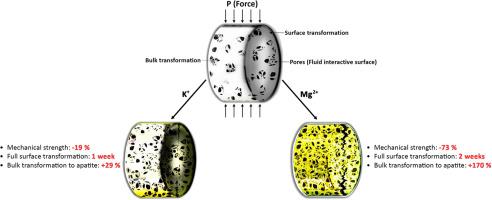Materials Today Communications ( IF 3.7 ) Pub Date : 2021-09-27 , DOI: 10.1016/j.mtcomm.2021.102838 Sahin Altundal 1 , Karlis Agris Gross 1 , Marco Laurenti 2 , Enrique López-Cabarcos 2 , Jorge Rubio-Retama 2

|
As a starting cement material, brushite is beneficial due to its short setting time and fast resorbability, and is metastable, allowing in vivo and in vitro transformation into a more stable calcium phosphate (CaP) phase. The challenges for a successful application of brushite include tissue inflammation from its acidic nature, and poor mechanical strength from weakly compacted crystals. Thus, in this study, it is aimed to avoid these drawbacks through a chemical modification of brushite cement. To circumvent tissue inflammation, brushite was modified with 5% of K+ or Mg2+ to induce the transformation into a more stable phase like hydroxyapatite (HAp). Surface transformation in a Tas-stimulated body fluid (Tas-SBF) solution occurred faster for K+-modified cements (1 week, to HAp and β-TCP) than for unmodified brushite (2 weeks, to HAp), and Mg2+-modified brushite (2 weeks, to HAp and β-TCP). Bulk transformation depended on the penetration of the Tas-SBF solution. Thus, Mg2+-substituted cement exhibited the most apatitic structure (26 wt%) due to the highest porosity. To improve the mechanical properties of brushite, setting retardants (acid pyrophosphate, citric acid) and an excess amount of β-TCP as a filler material were included in the cement’s composition. Diametral tensile strength (DTS) was the highest for unsubstituted cements (4.96 ± 1.04 MPa), slightly lower for K+-enriched cement (4.01 ± 0.71 MPa), and lowest for Mg2+-doped cements (1.34 ± 0.23 MPa). This study shows that it is possible to induce the transformation of brushite cement into a more biocompatible bone-like cement and simultaneously achieve enhanced mechanical properties through compositional modification of the cement.
中文翻译:

模拟血液条件下钾镁改性高性能透钙磷石水泥向碳酸磷灰石的转化动力学
作为起始水泥材料,透钙磷石因其凝结时间短和可吸收性快而有益,并且是亚稳态的,允许在体内和体外转化为更稳定的磷酸钙 (CaP) 相。成功应用透钙磷石的挑战包括其酸性性质引起的组织炎症,以及弱压实晶体引起的机械强度差。因此,在本研究中,旨在通过透钙磷石水泥的化学改性来避免这些缺点。为了避免组织炎症,透钙石用 5% 的 K +或 Mg 2+进行改性,以诱导转化为更稳定的相,如羟基磷灰石 (HAp)。Tas刺激的体液中的表面转变( Tas-SBF) 解决 K +改性水泥(1 周,HAp 和 β-TCP)比未改性透钙磷石(2 周,HAp)和 Mg 2+改性透钙磷石(2 周,HAp 和 β )更快-TCP)。体转化取决于Tas- SBF 溶液的渗透。因此,Mg 2+取代的水泥由于最高的孔隙率而表现出最多的磷灰石结构(26wt%)。为了提高透钙磷石的机械性能,在水泥组合物中加入了缓凝剂(酸性焦磷酸盐、柠檬酸)和过量的 β-TCP 作为填充材料。未取代水泥的径向拉伸强度 (DTS) 最高 (4.96 ± 1.04 MPa),K +略低- 强化水泥 (4.01 ± 0.71 MPa),最低的是掺杂Mg 2+ 的水泥 (1.34 ± 0.23 MPa)。该研究表明,有可能将透钙磷石水泥转化为更具生物相容性的骨样水泥,同时通过对水泥的成分改性来提高机械性能。











































 京公网安备 11010802027423号
京公网安备 11010802027423号